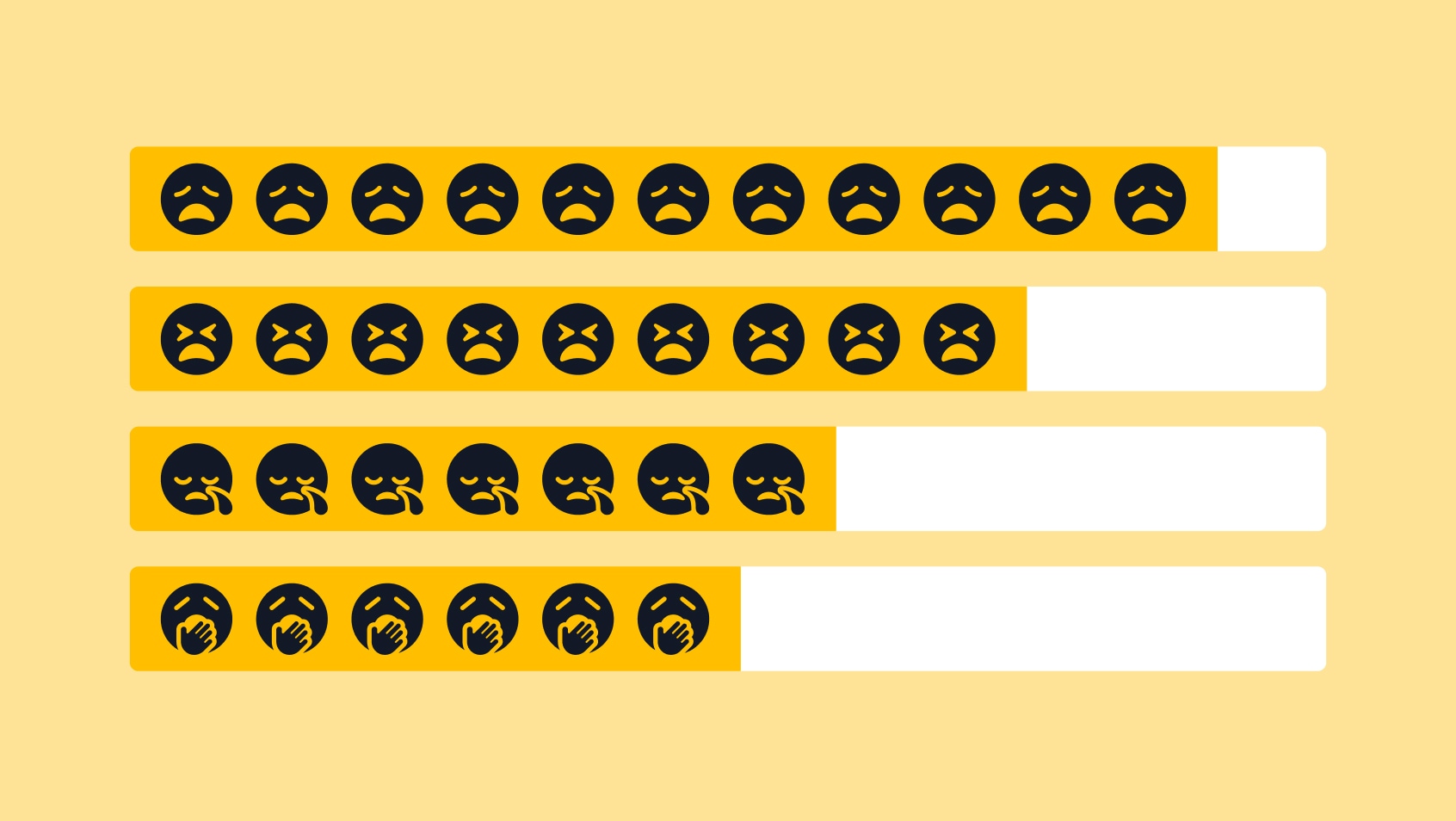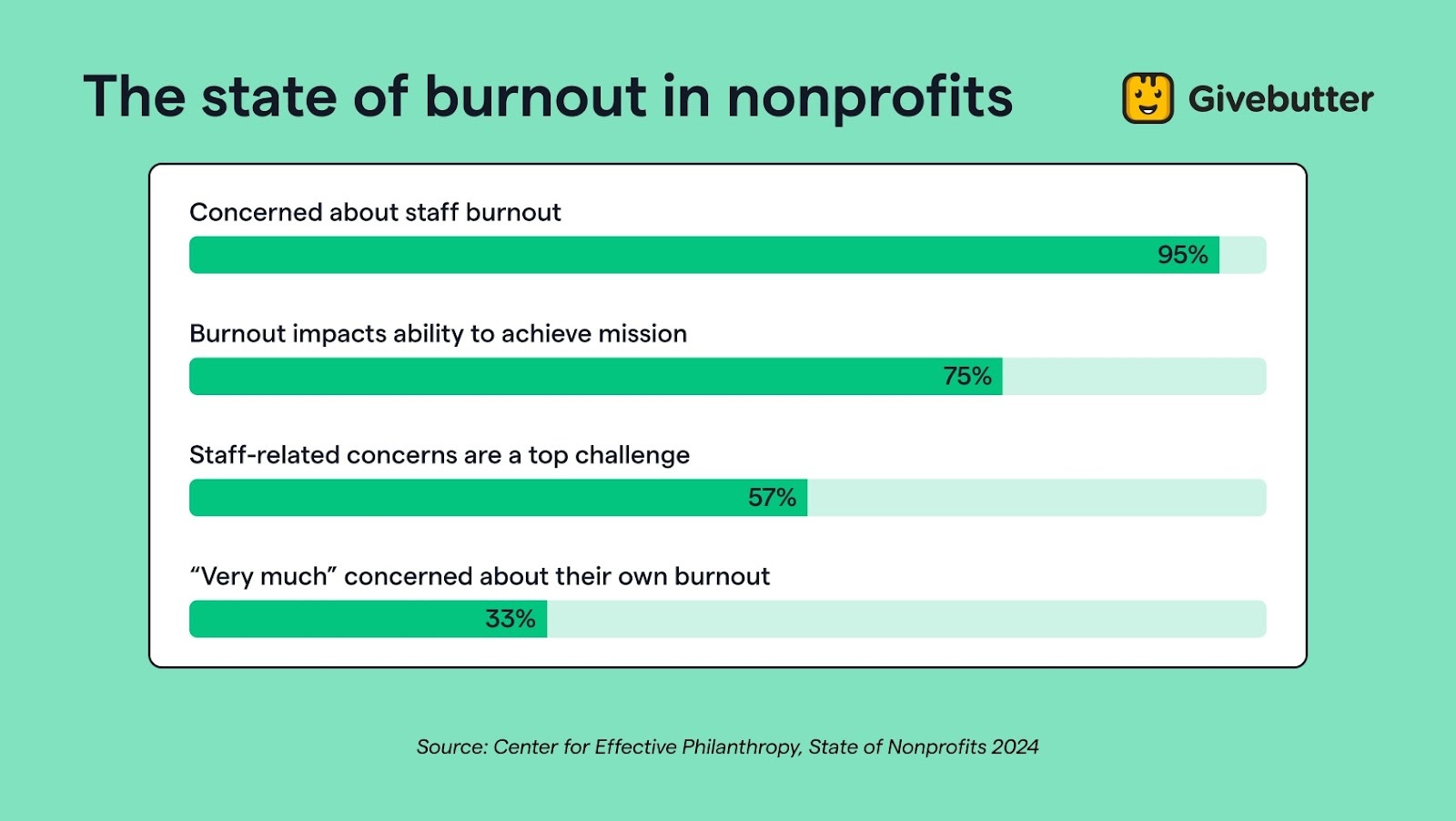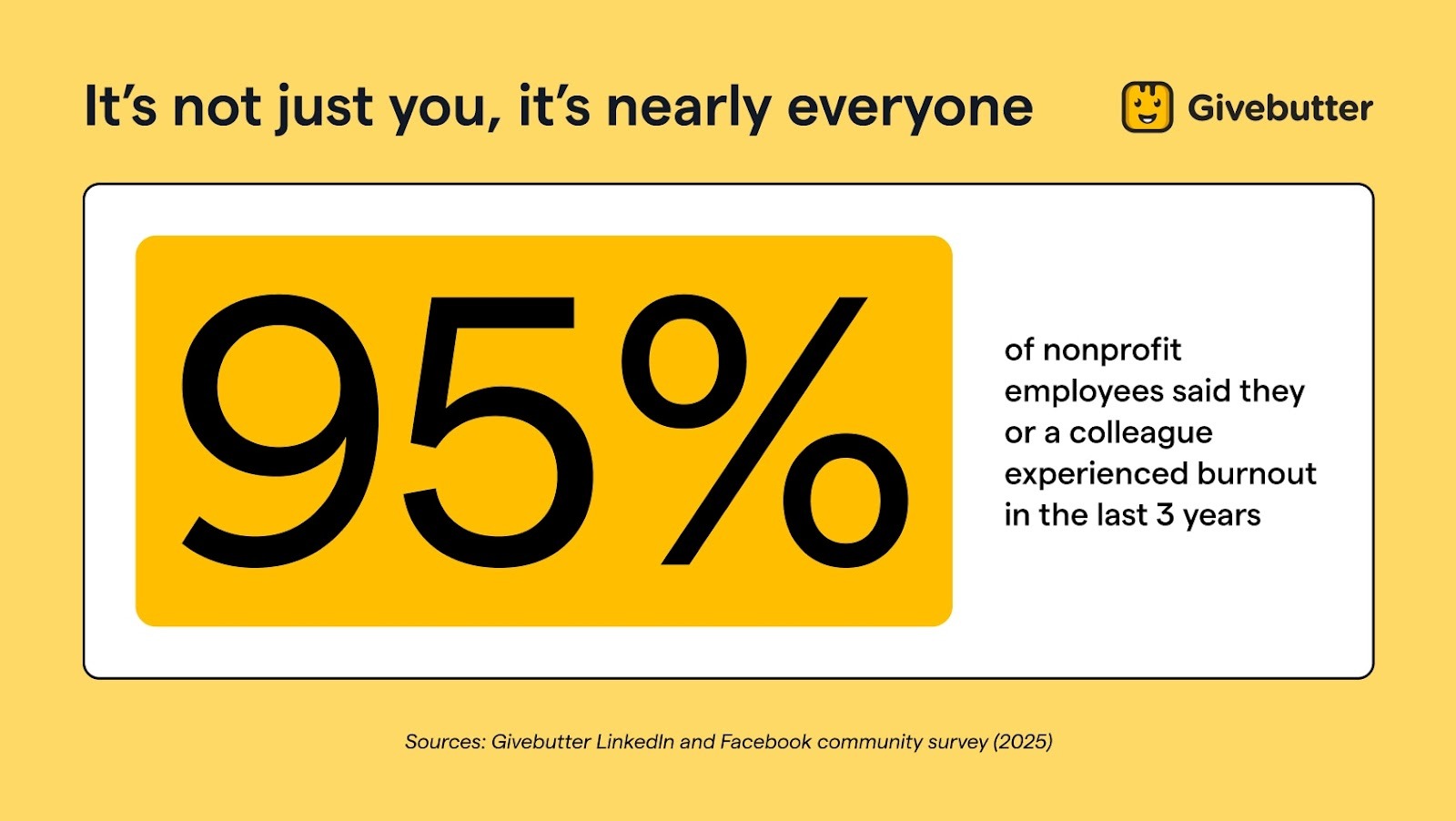Table of contents
Table of contents
Please note: This article is intended for informational purposes only and isn’t a substitute for professional medical advice, diagnosis, or treatment. If you are experiencing severe or persistent symptoms of burnout or any mental health crisis, please seek help from a qualified professional. If you or a loved one needs immediate support, the NAMI HelpLine provides resources and assistance to people navigating mental health challenges.
Like so many bright-eyed changemakers, Floyd Jones went all in when he started his career in nonprofit fundraising.
“I was so committed to the mission,” he says. But his enthusiasm led to his taking on more and more tasks until he was totally underwater:
“I really put the mission above myself. How could I not? I was able to do all these amazing, unique things, but I conflated who I was with what I did. I had a lack of boundaries.”
If Floyd’s story sounds familiar, you’re not alone. In this article, we delve into the true costs of burnout and share research-backed strategies for breaking the cycle to better protect the well-being and sustainability of both the individuals who serve and the vital organizations they support.
Nonprofit burnout statistics
In the demanding world of nonprofits, the passion that fuels long hours is too often met with limited resources and support. From overextended executive directors to exhausted frontline staff, organizations across the country are seeing record levels of burnout and staff turnover, leading to what many are calling a nonprofit workforce crisis.
The Center for Effective Philanthropy’s (CEP) recent State of Nonprofits 2024 report found the following troubling trends:
- 95% of nonprofit leaders surveyed expressed concern about staff burnout
- 75% shared that burnout among staff is at least slightly impacting their organization’s ability to achieve its mission
- 57% identified staff-related concerns as one of their biggest challenges
- 33% said they are “very much” concerned about their own burnout, with half reporting that they’re more concerned now than the previous year
Additionally, leaders in the CEP study who identified as people of color reported higher concerns about the impact of burnout on their organizations, and LGBTQ+ and women leaders reported greater concerns about their own burnout.
Burned out or just busy? Symptoms of nonprofit burnout
For Nikki Lavette, burnout from her nonprofit job came with both physical and emotional symptoms:
“You’re highly withdrawn, you’re highly anxious. Some of my indicators were my eating habits, my sleeping habits, and my peak illness—I kept getting colds, sinus infections, and stomach aches. I never felt well.”
Burnout isn't just regular work stress. It's a specific form of exhaustion, cynicism, and reduced professional effectiveness that stems from the unique pressures of the sector.
Driven by a deep passion for their cause, dedicated changemakers can find their commitment eroding due to relentless workloads, the emotional toll of working with vulnerable or traumatized populations, and the constant strain of fundraising and tight budgets.
As it did for Nikki, nonprofit burnout can manifest in a variety of ways.
Emotional signs of burnout
- Emotional exhaustion: Feeling drained, fatigued, and lacking the energy to face work. This is a core characteristic of burnout
- Irritability and anxiety: Increased impatience, short temper, and feeling constantly tense or worried
- Cynicism and detachment: Developing a negative or even callous attitude toward the organization, colleagues, or beneficiaries
- Procrastination and avoidance: Putting off important tasks, skipping meetings, or calling in sick more often
- Decline in performance: A noticeable drop in productivity, quality of work, and missing deadlines
- Reduced sense of accomplishment: Feeling ineffective, lacking confidence in one's abilities, and an inability to see the positive impact of one's work
Physical signs of burnout
- Difficulty concentrating: Struggling to focus on tasks, remember information, or make decisions
- Chronic fatigue: Persistent tiredness that isn't relieved by rest or sleep
- Frequent illnesses: A weakened immune system leading to more frequent colds, flu, or other infections
- Changes in sleep patterns: Experiencing difficulty falling or staying asleep, or sleeping too much
- Aches and pains: Unexplained headaches, stomach problems, or muscle pains
- Unhealthy coping mechanisms: Relying on alcohol, smoking, or drugs to deal with stress
Recognizing these signs early is key. The sooner burnout is identified, the sooner individuals and organizations can take steps to create healthier workplaces and restore balance.
What causes nonprofit burnout?
Nikki Lavette explains the root causes of burnout in terms of stress inputs and outputs:
- High stress outputs: Working too hard, on too many things, for too many hours
- High stress inputs: The expectations, obligations, and responsibilities of nonprofit roles
- High stress ratio: Pressures from filling more than one role, plus the higher visibility and greater demand for your availability that comes with more responsibility
But the stressors that lead to burnout don’t happen in a vacuum. Systemic issues are very much at play, with funding—or rather underfunding—at the top of the list. From teaching and nursing to social work, care-related professions have consistently paid less than other fields. Combine decades of cuts to social services, and you’ve got a workforce of passionate professionals who are overextended and undervalued.
In fact, pay at many organizations is so low that Independent Sector’s recent Health of the U.S. Nonprofit report found that 22% of nonprofit workers struggle to afford basic necessities.
If nonprofits account for 12.8 million jobs in the US—nearly one in ten private-sector employees—that means millions of nonprofit employees are living paycheck to paycheck, often without the benefits, pensions, and union protections that many public-sector employees rely on.
With the immense stress that living in poverty creates, it’s no surprise that so many nonprofit workers are set up for burnout from the get-go.
Related to underfunding, other common issues in nonprofit workplaces that lead to burnout include:
- Unrealistic expectations: Nonprofit funders and boards often expect “maximum impact with minimal overhead,” creating impossible workloads.
- Wearing too many hats: Nonprofit staff often juggle multiple tasks, including fundraising, marketing, programming, operations, and administration, with little to no relief.
- Compassion fatigue: Constant exposure to others’ hardships can take an emotional toll, especially for direct-service organizations.
- Lack of managerial or board support. Without transparent communication or shared accountability, leaders and staff feel isolated.
- Poor work-life boundaries. Many nonprofit professionals feel guilty saying “no” because they care deeply about the mission.
- Organizational change or instability. Rapid shifts in funding, leadership, or priorities can create uncertainty and stress.
Each of these factors chips away at morale—and when left unchecked, they contribute to high employee turnover in nonprofit organizations, low employee retention, and weakened mission effectiveness.
The high costs of burnout for nonprofit organizations
Burnout doesn’t just drain individuals—it costs entire organizations.
With a nonprofit turnover rate of approximately 19%, compared to 12% in other sectors, burnout is costing organizations valuable time, talent, and resources they can’t afford to lose.
In response to the Social Impact Staff Retention Project 2025 survey, nearly 7 in 10 nonprofit employees reported that they would be looking for a new job this year. Their top reasons may sound familiar:
- 59% have too much responsibility and not enough support
- 54% see no clear growth opportunities
- 52% face unsupportive management and leadership
Similarly, half of the respondents in the National Council of Nonprofits’ report on the workforce shortage cited stress and burnout as a top challenge to recruitment and retention.
Improving employee retention in nonprofit organizations isn’t just good for morale—it’s essential for sustainability. Let’s explore the impact burnout can have on organizations.
Financial costs 💸
Burnout often leads to turnover, and losing an employee can cost an organization between 33% and 200% of an employee’s annual salary. These costs include hiring, onboarding, training, loss of engagement among other employees, and higher organizational errors. Add in decreased morale and delayed projects, and the cost to mission impact multiplies.
Interruptions to the mission 🚧
When someone leaves, their work doesn’t disappear—it gets redistributed to already stretched teammates. Valuable relationships, systems, and insights often go with them.
Turnover can create a domino effect: increased workloads → higher stress → more turnover. Meanwhile, core programs stall and fundraising efforts lose momentum.
Fundraiser fatigue, meet donor fatigue 🤝
Burned-out fundraisers can unintentionally pass that fatigue to their donors.
“Authenticity and vulnerability build great human connections,” explains Becky Endicott of We Are For Good, who herself experienced severe burnout as a nonprofit fundraiser:
“If you are in rote mode, where you are doing things the way they’ve always been done, you’re plowing through, and you’re not creating a culture of listening or trying new things, your donors are going to feel that.”
We asked the Givebutter Fam
The Givebutter community comprises thousands of changemakers dedicated to making the world a better place. They, too, have experienced burnout firsthand.
We polled our followers on LinkedIn and Facebook, and of 46 respondents, 44 people—over 95%—said that they or a colleague had experienced burnout in the past three years.
One respondent shared what burnout meant for them personally:
“I’ve thrived wearing multiple hats while juggling countless duties and being the go-to for getting things done efficiently. But passion has its limits, and burnout reminded me that rest (both mental & physical) is just as important as the work itself.”
Burnout causes harm for individuals and the organizations and communities they serve—so what can be done to prevent it?
How can nonprofits prevent burnout?
“Burnout comes from working conditions,” explains Becky Endicott. Employee retention starts with nonprofit leaders listening and creating a work culture where staff feel supported, valued, and empowered.
So, what does it look like to build that kind of supportive culture in practice? The following strategies can help create a healthier environment and employee engagement at nonprofit organizations, reducing burnout at every level.
Acknowledge and address burnout openly 🗣️
Normalize conversations about capacity and workload. Don’t just encourage regular check-ins and mental health days—write them into your policies.
A proactive burnout assessment can help your organization identify early warning signs before burnout takes hold. Here’s how to run one:
- Survey staff quarterly about workload, stress, and morale.
- Assess results by department or role to spot systemic issues.
- Create action plans (e.g., redistribute work, hire support, set new boundaries).
- Revisit progress regularly to ensure changes are making an impact.
Consider pairing this with one-on-one check-ins or anonymous forms to ensure honesty and trust.
Confront the “Overhead Myth” 🖐️
"For decades, the nonprofit industry has been held to unrealistic expectations and outdated metrics that keep organizations from growing,” explains Givebutter Expert Sherry Quam Taylor. “The most insidious? [The belief that] nonprofits should be able to do more on less.”
“Not only are nonprofits supposed to change the world or solve huge crises, they’re expected to do it on shoestring budgets."
Too often, nonprofit leaders and funders have unrealistic expectations for the value of an employee’s time. Many are tempted to skimp on overhead costs to funnel more funds “toward the mission,” feeding into the Overhead Myth.
The reality is that when you invest in the people behind the mission, your effectiveness in reaching your goals increases tenfold. Nonprofits should invest in their employees' long-term success by providing them with the necessary support. Fair compensation, flexible hours, and workload transparency go a long way in preventing resentment and fatigue.
Balance everyone’s workload ⚖️
Nonprofit executive directors who experience burnout, and consequently their staff, tend to share a few commonalities. They don’t delegate tasks, communicate strategic direction, or help staff members stay focused on the mission on a day-to-day basis.
Please hear this, nonprofit leaders: You cannot (and should not!) shoulder this work alone. A great way to avoid burnout is to dust off your coaching skills and start delegating. Meet with team members regularly to discuss their responsibilities and ensure they have all the necessary resources to perform their job effectively.
“Major funders are looking for this balance,” explains Becky Endicott, noting that big funders like MacKenzie Scott have been making large gifts not just based on the healthiness of an organization’s finances, but on the healthiness of the culture. “If we don’t start to lead with it, not only are we going to lose incredible talent, but we have the opportunity to lose really big dollars and people who want to be a part of vibrant cultures.”
Set aside time for personal and professional development 🧠
Employees who can learn and advance are more likely to stay engaged and motivated. Changemakers seek to work in an environment that allows them to advance their professional careers and develop their skills.
Likewise, many executives identified coaching, peer networks, and leadership development programs as the top three most effective strategies for nonprofit leadership development and support.
Practical tips for staying balanced and avoiding burnout
While much of the solution to burnout stems from systemic changes, individuals can cultivate practices that help them reduce stress and stay healthy, both for themselves and their missions.
Simple self-care activities, such as getting active, taking a break from screens, and spending quality time with loved ones, can help everyone achieve a better work-life balance. For nonprofit leaders of color in particular, sabbaticals and rest are paramount.
Nikki Lavette also emphasizes the importance of relating to others in your community who have experienced burnout. “Stress affects how engaging, empathetic, and effective we are,” she says, encouraging all nonprofit staff to:
“Rework the way you work, recover, and reframe the things innate to you that are contributing to your stress… so that you can have impact in the moments that matter.”
In interviews with potential nonprofit employers, Nikki urges changemakers not to be afraid to ask about mental health policies and other benefits.
Other burnout prevention tips for changemakers:
- Set clear goals and boundaries, and communicate them clearly.
- Delegate and collaborate—no one can carry a mission alone.
- Advocate for sustainable funding, workloads, and mental-health support.
- Use tools that reduce admin work.
- Establish peer support circles to foster accountability and empathy.
- Celebrate progress, not perfection.
Work smarter, not harder, with Givebutter
Burnout isn’t inevitable—it’s a warning sign that systems and work environments need to change.
When nonprofits invest in their people through sustainable practices, equitable pay, and modern tools, they don’t just prevent burnout and slow high turnover rates—they strengthen their missions.
Givebutter was built to give all nonprofits access to easy, modern tools that take the stress out of fundraising, donor management, and supporter engagement, without the high costs.
We look forward to a future where sustainable impact is the standard, and true well-being—for the cause and the people driving it—is not an afterthought, but the foundation of a thriving nonprofit sector.
💛 Get started with Givebutter today →
Nonprofit burnout statistics infographic
Want to share these insights with your team or audience? Download the full burnout infographic for a snapshot of the latest nonprofit burnout data.
FAQs about burnout in nonprofit organizations
What is nonprofit burnout?
Nonprofit burnout is a state of emotional, mental, and physical exhaustion resulting from chronic stress stemming from overwork, underfunding, and mission-driven pressure. Recognizing it early is the first step toward building a healthier, more sustainable work culture.
How common is burnout in nonprofits?
In 2025, 95% of nonprofit leaders cited burnout as a major challenge, with 30% of staff already experiencing it. The good news? More organizations are now prioritizing wellness and flexible systems to support their teams.
How can nonprofits prevent burnout?
Prevent burnout by prioritizing mental health, fair pay, balanced workloads, and automation. When nonprofits invest in their people, they build the energy and focus needed to power their mission.
What’s the difference between burnout and compassion fatigue?
Burnout is cumulative exhaustion from ongoing stress; compassion fatigue stems from emotional overexposure to others’ suffering. Both can improve with intentional rest, support, and systemic change.
How long does recovery take?
Recovery depends on the severity—many employees require several months and structural workplace changes to fully restore balance. But with sustained rest and organizational change, nonprofit professionals can regain their motivation and sense of purpose.
.svg)






%20(1).png)



.svg)













.webp)




